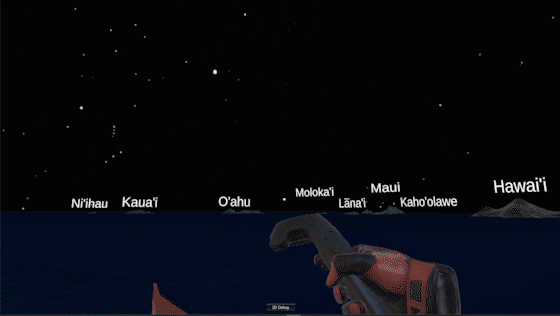Quick view of the Create(x) lab at the University of Hawai'i at West O'ahu
Wao Ki'i is built for the Create(x) immersive projector system. The projector system projects onto the three walls of the Create(x) lab to create in immersive space that includes peripherals (such as the Azure Kinect) to allow user interactivity. I designed the projector system to be similar to the systems deployed in digital art museums, such as teamLab, but with the space and ceiling height limitations we have at Create(x).
Extended Reality (XR) technologies continue to be utilized to create cultural heritage exhibitions and records to preserve and transmit ancestral knowledge. New media technology offers opportunities to create immersive spaces that allow visitors to not only learn from, but also affect the environment they are invited into. Through the design of Wao Ki'i we analyzed our own methodology for creating immersive exhibitions to determine ways in which we could design that brought value not only to GLAM patrons, but to the community of cultural heritage.
Wao Ki'i (fig. realm of images) allows users to populate Hawaiian forests with endemic species and weather through a visual interface inspired from visual programming.
To utilize Wao Kiʻi, patrons will match the colored tiles to the tile board to create sentences. There is no English on the board, so the colored tiles and tile board were developed to support the use the system without the need for translation. The order of the tiles is similar to a pepeke painu sentence structure, one of the simplest sentence structures in ʻŌlelo Hawai’i. The meaning of these generated sentences controls the form and action of the small character that is displayed. In this way, if a visitor were to create the sentence “Lele koke ka ʻi’iwi,” the small character will turn into an ʻi’iwi bird that will begin to fly (lele) fast (koke).
We chose to withhold any non-Hawaiian words from the design of the system, tiles, and constructed sentences to encourage experimentation and discovery for patrons who are not fluent in the Hawaiian language. Through switching out the tiles in the correct positions, the character’s form and actions will change, which will imply the definition of the various words to the patron. Once the patron is satisfied with their sentence, they will be able to transfer the generated character to the projected mural, where the unique action and attributes of the character will be saved and will continue to live within the surrounding digital forest.
The design of the project was built around the thought that the more visitors successfully create Hawaiian sentences to create unique characters, the more diverse and abundant the digital forest becomes.
Example of wall transfer from table to mural.
Derived from Indigenous guidelines, methodologies, and frameworks for research, media, and technology development involving Indigenous cultural heritage, the Framework for the Equitable Design for Cultural Heritage Immersive Experiences (my MS thesis which can be read here) was created through the early iterations of the Wao Ki'i prototype, and guides its more current iterations. The framework describes design considerations such as:
Positionally: The relation and influence that one’s own identity, biases, and profession has towards a community and its cultural heritage.
Locality: The historical and cultural context of the location of the cultural heritage in relation to the community, exhibition location, and exhibit environment.
Sovereignty: The creation of capacity for community descendants to have authority and voice for the narrative, presentation, data, user experience, protocol of knowledge transmission, and creative expression within the environment.
Responsibility: The responsibility the developer has to support the community of the cultural heritage in ways defined by the community collaborators on the
development team, to provide reciprocity, to do no harm, and to provide access to the resulting exhibit and its assets to the community.
development team, to provide reciprocity, to do no harm, and to provide access to the resulting exhibit and its assets to the community.
Feedback: The creation and implementation of proper methods for collecting, analyzing, and archiving feedback from both cultural heritage experts and the general community of the cultural heritage derived from the
communities needs."
communities needs."
Wao Kiʻi is the first of what we hope to be many projects in Create(x), so we intended to use its development and design as an opportunity to improve our processes so that we may better generate and retain knowledge throughout the design process that may improve future projects.
Through the design process, we have been able to record key themes and lessons that will aid us in our continuing development of immersive exhibitions. We do understand that each design process is unique, and the methods and solutions will be different based on the context of each project, but we believe through analyzing our own design process there is the possibility of discovering new design patterns, which will make it easier for new designers to learn how to improve their skill.
As for cultural heritage exhibitions, it is also important to understand and be able to express the reasons for design decisions, as the community members of the cultural heritage will likely want to know. The decisions of the design must be clearly communicated so community collaborators can understand possible restrictions and requirements so that they may also make informed improvements to the design when they may lack the knowledge of the technological or logistical side of the exhibition. Overall, the process of design is a story in itself that must be told well to build trust in the community.





